Honeywell 60s User Manual

Dolphin 60s
with Windows® Embedded Handheld 6.5
User’s Guide

Disclaimer
Honeywell International Inc. (“HII”) reserves the right to make changes in specifications and other information contained in this document without prior notice, and the reader should in all cases consult HII to determine whether any such changes have been made. The information in this publication does not represent a commitment on the part of HII.
HII shall not be liable for technical or editorial errors or omissions contained herein; nor for incidental or consequential damages resulting from the furnishing, performance, or use of this material.
This document contains proprietary information that is protected by copyright. All rights are reserved. No part of this document may be photocopied, reproduced, or translated into another language without the prior written consent of HII.
Web Address: www.honeywellaidc.com
Trademarks
Dolphin is a trademark or registered trademark of Hand Held Products, Inc. in the United States and/or other countries.
Microsoft, Windows, Windows Mobile, Windows Phone, Windows Embedded Handheld, Windows CE, Windows 98 Second Edition, Windows NT, Windows 2000, Windows ME, Windows XP, Windows 7, Windows Vista, ActiveSync, Outlook, and the Windows logo are trademarks or registered trademarks of Microsoft Corporation.
The Bluetooth trademarks are owned by Bluetooth SIG, Inc., U.S.A. and licensed to Honeywell.
Other product names mentioned in this manual may be trademarks or registered trademarks of their respective companies and are the property of their respective owners.
Patents
For patent information, please refer to www.hsmpats.com.
2013-2014 Honeywell International Inc. All rights reserved.

Table of Contents
Chapter 1 - Dolphin 60s Terminal Agency Information
Label Locations.................................................................................................................... |
1-1 |
Model Number, Serial Number and IMEI Labels............................................................ |
1-1 |
LED Safety........................................................................................................................... |
1-1 |
LED Safety Statement.................................................................................................... |
1-1 |
UL and C-UL Statement....................................................................................................... |
1-2 |
Approvals by Country........................................................................................................... |
1-2 |
R&TTE Compliance Statement—802.11b/g/n, Bluetooth, and/or GSM............................... |
1-2 |
FCC Requirements .............................................................................................................. |
1-2 |
Dolphin RF Terminal—802.11b/g/n, Bluetooth, and/or GSM ......................................... |
1-2 |
Canadian Compliance.......................................................................................................... |
1-3 |
Conformité à la règlementation canadienne .................................................................. |
1-3 |
RF Exposure Information (SAR) .......................................................................................... |
1-3 |
IC Radiation Exposure Statement........................................................................................ |
1-4 |
CE SAR Compliance............................................................................................................ |
1-4 |
CE Country Codes ............................................................................................................... |
1-5 |
Honeywell Scanning & Mobility Product Environmental Information.................................... |
1-5 |
China RoHS ......................................................................................................................... |
1-5 |
Pacemakers, Hearing Aids and Other Electrically Powered Devices .................................. |
1-5 |
Hearing Aid Compatibility (HAC).......................................................................................... |
1-5 |
Microwaves .......................................................................................................................... |
1-6 |
Informações ANATEL (Modelos: 60sLP e 60sL0) ............................................................... |
1-6 |
Chapter 2 - Getting Started |
|
Out of the Box ...................................................................................................................... |
2-1 |
Initial Setup for Dolphin 60s Terminals ................................................................................ |
2-1 |
Using the USB Charge/Communication Cable (Model USB-WALL-CHARGER-1) ....... |
2-2 |
The Home Screen................................................................................................................ |
2-4 |
Title Bar.......................................................................................................................... |
2-4 |
Icons in the Title Bar ...................................................................................................... |
2-4 |
Horizontal Scroll ............................................................................................................. |
2-7 |
Tile Bar........................................................................................................................... |
2-7 |
Optional Virtual Keyboard .............................................................................................. |
2-7 |
The Start Menu .................................................................................................................... |
2-9 |
Navigating the Start Menu.............................................................................................. |
2-9 |
Pop-Up Menus ..................................................................................................................... |
2-9 |
File Explorer....................................................................................................................... |
2-10 |
File Provisioning on the Dolphin 60s.................................................................................. |
2-11 |
Search................................................................................................................................ |
2-11 |
Suspend Mode ............................................................................................................. |
2-12 |
Replacing the Main Battery................................................................................................ |
2-12 |
Resetting the Terminal....................................................................................................... |
2-13 |
Soft Reset (Warm Boot) ............................................................................................... |
2-13 |
Hard Reset (Cold Boot)................................................................................................ |
2-13 |
iii

Chapter 3 - Hardware Overview
Standard Configurations for the Dolphin 60s....................................................................... |
3-1 |
Peripherals for the Dolphin 60s ........................................................................................... |
3-2 |
Accessories for the Dolphin 60s .......................................................................................... |
3-2 |
Features of the Dolphin 60s ................................................................................................ |
3-4 |
Front Panel .................................................................................................................... |
3-4 |
Feature Descriptions: Front Panel ................................................................................. |
3-5 |
Back Panel..................................................................................................................... |
3-7 |
Feature Descriptions: Back Panel ................................................................................. |
3-8 |
The I/O Connector ............................................................................................................. |
3-10 |
Battery ............................................................................................................................... |
3-10 |
Charging Options......................................................................................................... |
3-10 |
Charging Time ............................................................................................................. |
3-11 |
Important Charging Guidelines .................................................................................... |
3-11 |
Battery Error Notification.............................................................................................. |
3-12 |
Storing Batteries .......................................................................................................... |
3-13 |
Guidelines for Battery Pack Use and Disposal ............................................................ |
3-13 |
Managing Battery Power ............................................................................................. |
3-14 |
Checking Battery Power .............................................................................................. |
3-14 |
System Resets .................................................................................................................. |
3-15 |
Hardware Maintenance ..................................................................................................... |
3-15 |
Installing a SIM Card and/or Memory Card ....................................................................... |
3-15 |
Chapter 4 - Using the Scan Image Engine |
|
Overview.............................................................................................................................. |
4-1 |
LED Safety .......................................................................................................................... |
4-1 |
Image Engine Specifications ............................................................................................... |
4-1 |
Field of View .................................................................................................................. |
4-1 |
Depth of Field ................................................................................................................ |
4-1 |
Supported Bar Code Symbologies ..................................................................................... |
4-2 |
Decoding ............................................................................................................................. |
4-3 |
Using the Scan Demo to Decode a Bar Code ............................................................... |
4-3 |
The Aiming Beam .......................................................................................................... |
4-3 |
Capturing Images Using the Imaging Demo........................................................................ |
4-4 |
Taking an Image ............................................................................................................ |
4-4 |
Uploading Images.......................................................................................................... |
4-5 |
Chapter 5 - Using the Color Camera |
|
Overview.............................................................................................................................. |
5-1 |
Taking a picture using the Camera Demo tool .................................................................... |
5-1 |
Taking a picture using the Windows Embedded Handheld 6.5 Camera tool ...................... |
5-4 |
Recording Video using the Windows Embedded Handheld 6.5 Camera Tool .................... |
5-6 |
Uploading Pictures and Videos ........................................................................................... |
5-6 |
iv

Chapter 6 - Using the Keyboards
Available Keyboards............................................................................................................ |
6-1 |
Keyboard Combinations ................................................................................................ |
6-1 |
Common Buttons ........................................................................................................... |
6-1 |
Using the Function Keys...................................................................................................... |
6-1 |
Using the Modifier Keys ...................................................................................................... |
6-3 |
Using the Navigation Keys .................................................................................................. |
6-3 |
30-Key Numeric Keyboard .................................................................................................. |
6-4 |
30-Key Numeric Keyboard Combinations...................................................................... |
6-4 |
46-Key QWERTY Keyboard ................................................................................................ |
6-6 |
46-Key QWERTY Keyboard Combinations ................................................................... |
6-6 |
Chapter 7 - System Settings |
|
Overview.............................................................................................................................. |
7-1 |
Clock & Alarms .................................................................................................................... |
7-2 |
Lock ..................................................................................................................................... |
7-3 |
Personal Menu .................................................................................................................... |
7-4 |
Buttons........................................................................................................................... |
7-5 |
System Menu....................................................................................................................... |
7-8 |
About ............................................................................................................................. |
7-9 |
Backlight ...................................................................................................................... |
7-11 |
Battery ......................................................................................................................... |
7-12 |
Certificates................................................................................................................... |
7-14 |
Encryption.................................................................................................................... |
7-14 |
Error Reporting ............................................................................................................ |
7-15 |
HSM SystemInfo.......................................................................................................... |
7-15 |
SIP Config.................................................................................................................... |
7-15 |
Managed Programs ..................................................................................................... |
7-16 |
Memory........................................................................................................................ |
7-17 |
Power........................................................................................................................... |
7-18 |
Regional Settings......................................................................................................... |
7-19 |
Remove Programs....................................................................................................... |
7-20 |
RIL ............................................................................................................................... |
7-20 |
Screen ......................................................................................................................... |
7-21 |
Task Manager.............................................................................................................. |
7-22 |
Chapter 8 - Communication |
|
Connections Menu............................................................................................................... |
8-1 |
Microsoft Connections Application ...................................................................................... |
8-2 |
Dolphin Wireless Manager .................................................................................................. |
8-5 |
Dolphin Wireless Manager Window............................................................................... |
8-5 |
Enabling the Radios....................................................................................................... |
8-6 |
Accessing Radio Configuration Utilities ......................................................................... |
8-7 |
USB to PC ........................................................................................................................... |
8-8 |
Network Cards..................................................................................................................... |
8-8 |
Connecting and Synchronizing the Terminal and Workstation............................................ |
8-9 |
v

Installing Additional Software ............................................................................................ |
8-11 |
Adding Programs Using ActiveSync or Windows Mobile Device Center..................... |
8-11 |
Connecting the Terminal to a Wireless Network.......................................................... |
8-12 |
Adding Programs Using the Internet............................................................................ |
8-12 |
Software Upgrades............................................................................................................ |
8-13 |
Dolphin 60s COM Port Assignment Table......................................................................... |
8-13 |
Chapter 9 - Working with Wireless Wide Area Networking (WWAN) |
|
Overview.............................................................................................................................. |
9-1 |
Requirements ................................................................................................................ |
9-1 |
Antenna Band ................................................................................................................ |
9-1 |
Signal Strength .............................................................................................................. |
9-1 |
Voice and Data Communication .................................................................................... |
9-2 |
Enabling the WWAN Radio ................................................................................................. |
9-3 |
Audio Modes........................................................................................................................ |
9-4 |
Volume Control .............................................................................................................. |
9-4 |
Voice Communication.......................................................................................................... |
9-4 |
Accessing the Dialer Window ........................................................................................ |
9-4 |
Accessing Voice Mail..................................................................................................... |
9-5 |
Customizing the Phone.................................................................................................. |
9-6 |
Data Communication ........................................................................................................... |
9-8 |
System Requirements ................................................................................................... |
9-8 |
Establishing Data Communication................................................................................. |
9-8 |
Manual Network Selection (GSM/UTMS) .................................................................... |
9-10 |
Chapter 10 - Working with the Bluetooth Radio |
|
Enabling the Bluetooth Radio ............................................................................................ |
10-1 |
Pairing and Trusted Devices ............................................................................................. |
10-2 |
Connecting to Other Bluetooth Devices ............................................................................ |
10-2 |
Transferring Files using Beam File.................................................................................... |
10-5 |
Making the Terminal Discoverable .................................................................................... |
10-6 |
Enabling the Terminal to Receive Incoming Beams.......................................................... |
10-6 |
Selecting COM Ports ......................................................................................................... |
10-6 |
Chapter 11 - Working with GPS |
|
Overview............................................................................................................................ |
11-1 |
Assisted GPS Support....................................................................................................... |
11-1 |
Powering the GPS Module ................................................................................................ |
11-1 |
Communication Port .......................................................................................................... |
11-1 |
COM7 .......................................................................................................................... |
11-1 |
GPS Intermediate Driver.............................................................................................. |
11-1 |
GPS Demo ........................................................................................................................ |
11-2 |
vi

Chapter 12 - Dolphin 60s HomeBase Device (Model D60s-HB)
Overview............................................................................................................................ |
12-1 |
Unpacking the HomeBase ........................................................................................... |
12-1 |
Charging Overview ...................................................................................................... |
12-1 |
Communications .......................................................................................................... |
12-1 |
Convenient Storage ..................................................................................................... |
12-2 |
Capacity....................................................................................................................... |
12-2 |
Dimensions .................................................................................................................. |
12-2 |
Weight.......................................................................................................................... |
12-2 |
Parts and Functions........................................................................................................... |
12-3 |
Front Panel ................................................................................................................. |
12-3 |
Back Panel .................................................................................................................. |
12-4 |
Bottom Panel ............................................................................................................... |
12-5 |
Power ................................................................................................................................ |
12-5 |
Connecting Power to the HomeBase........................................................................... |
12-5 |
Charging the Main Battery................................................................................................. |
12-6 |
To Power a Terminal and Charge its Main Battery...................................................... |
12-6 |
Charging a Spare Battery in the Auxiliary Battery Well ............................................... |
12-6 |
Communication.................................................................................................................. |
12-6 |
Requirements .............................................................................................................. |
12-7 |
Setting Up and Connecting the Dolphin Terminal to the HomeBase........................... |
12-7 |
Mounting the HomeBase ................................................................................................... |
12-7 |
Desk Mounting............................................................................................................. |
12-7 |
Chapter 13 - Dolphin 60s Mobile Charger Devices |
|
Overview............................................................................................................................ |
13-1 |
Charging Overview ...................................................................................................... |
13-1 |
Mobile Charger Components (60s-MC)............................................................................. |
13-1 |
Mobile Charger with DEX Cable Components (60s-DEXKIT) ........................................... |
13-2 |
Mobile Charger with DB9 Cable Components (60s-DB9KIT)............................................ |
13-3 |
Charging the Main Battery................................................................................................. |
13-3 |
To Power a Terminal and Charge its Main Battery...................................................... |
13-4 |
Chapter 14 - Customer Support |
|
Warranty Disclaimer: Proper Use of a Touch Screen Mobile Device ................................ |
14-1 |
Limited Warranty ............................................................................................................... |
14-1 |
How to Extend Your Warranty ..................................................................................... |
14-3 |
vii

viii
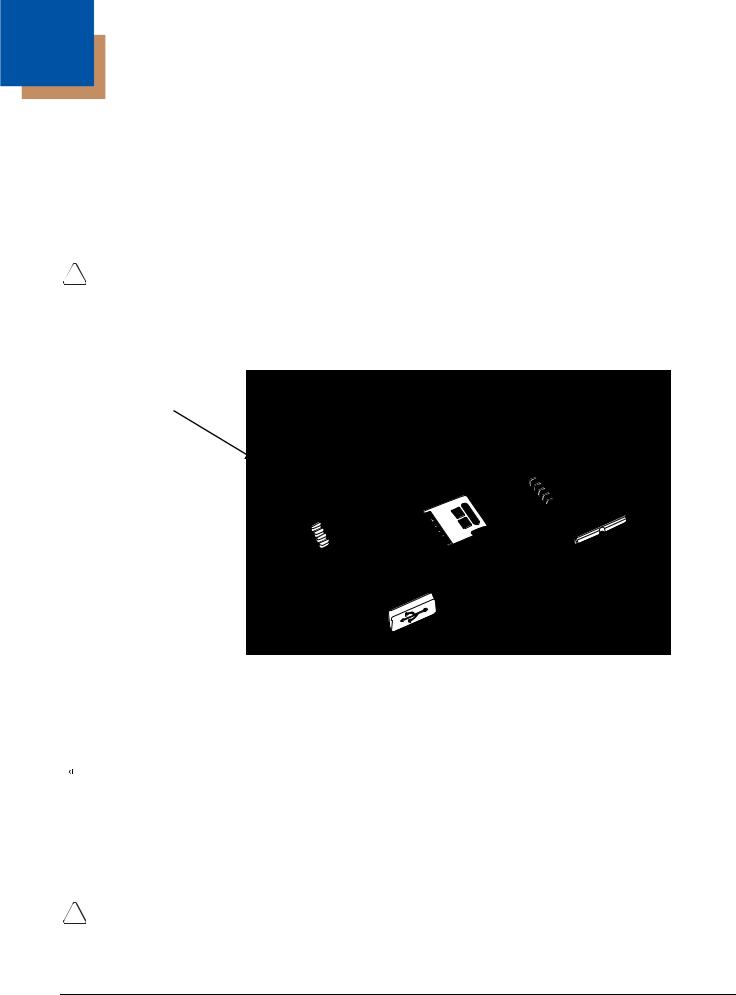
1
Dolphin 60s Terminal Agency Information
Dolphin 60s mobile computers meet or exceed the requirements of all applicable standards organizations for safe operation. However, as with any electrical equipment, the best way to ensure safe operation is to operate them according to the agency guidelines that follow. Read these guidelines carefully before using your Dolphin terminal.
This documentation is relevant for the following Dolphin models: 60sLU, 60sLE, 60sLP, and 60sL0.
!markings on the battery, charging peripheral, or device using the battery before attempting to install, use, or
charge the battery. Risk of fire and burns if improperly handled. Do not open, crush, heat above 60°C (140°F), or incinerate.CAUTION - Read the Guidelines for Battery Pack Use and Disposal on page 3-13 and all cautionary
Label Locations
Back Panel of the terminal |
Compliance Labels and Marks |
|
with the battery door and |
||
|
||
battery removed. |
|
Model Number, Serial Number and IMEI Labels
The model (item) number, serial number, and international mobile equipment identity (IMEI) number for the terminal are located on labels affixed to the bottom of the battery well.
 Warning! To prevent possible hearing damage, do not listen at high volume levels for long periods.
Warning! To prevent possible hearing damage, do not listen at high volume levels for long periods.
LED Safety
LED Safety Statement
LEDs have been tested and classified as “EXEMPT RISK GROUP” to the Standard: IEC 62471:2006.
!Caution! Do not view directly with optical instruments.
1 - 1

UL and C-UL Statement
UL and C-UL listed: UL60950-1 2nd Edition, and CSA C22.2 No. 60950-1-07 2nd Edition.
Underwriters Laboratories Inc. (UL) has not tested the performance or reliability of the global positioning system (GPS) hardware, GPS operating software or other GPS-related aspects of this product. UL has only tested for the explosion, fire, shock, and casualty hazards required by the applicable hazardous locations standards. UL certification does not cover the performance or reliability of the GPS hardware, GPS operating software, or other GPS-related aspects of this product. UL makes no representations, warranties, or certifications whatsoever regarding the performance or reliability of any GPS-related functions of this product.
Approvals by Country
Refer to the Honeywell Scanning & Mobility compliance center at www.honeywellaidc.com/compliance to review and download any publicly available documentation pertaining to the certification of this product in a given country.
R&TTE Compliance Statement—802.11b/g/n, Bluetooth, and/or GSM
The CE marking indicates compliance with the following directives:
•1995/5/EC R&TTE
• 2011/65/EU RoHS (Recast)
In addition, this product complies to 2006/95/EC Low Voltage Directive when supplied with the recommended power supply.
European Contact:
Hand Held Products Europe B.V.
Nijverheidsweg 9-13
5627 BT Eindhoven
The Netherlands
Honeywell shall not be liable for use of our product with equipment (i.e., power supplies, personal computers, etc.) that is not CE marked and does not comply with the Low Voltage Directive. The equipment is intended for use throughout the European Community; PAN European Frequency Range: 2.402–2.480 GHz.
FCC Requirements
Dolphin RF Terminal—802.11b/g/n, Bluetooth, and/or GSM
This device complies with Part 15 of the FCC Rules. Operation is subject to the following two conditions:
(1) this device may not cause harmful interference, and (2) this device must accept any interference received, including interference that may cause undesired operation.
This equipment has been tested and found to comply with the limits for a Class B digital device pursuant to Part 15 of the FCC Rules. These limits are designed to provide reasonable protection against harmful interference in a residential installation. This equipment generates, uses, and can radiate radio frequency energy and, if not installed and used in accordance with the instructions, may cause harmful
1 - 2

interference to radio communications. However, there is no guarantee that interference will not occur in a particular installation. If this equipment does cause harmful interference to radio or television reception, which can be determined by turning the equipment off and on, the user is encouraged to try to correct the interference by one or more of the following measures:
•Reorient or relocate the receiving antenna.
•Increase the separation between the equipment and receiver.
•Connect the equipment into an outlet on a circuit different from that to which the receiver is connected.
•Consult the dealer or an experienced radio/TV technician for help.
If necessary, the user should consult the dealer or an experienced radio/television technician for additional suggestions. The user may find the following booklet helpful: “Something About Interference.” This is available at FCC local regional offices. Our company is not responsible for any radio or television interference caused by unauthorized modifications of this equipment or the substitution or attachment of connecting cables and equipment other than those specified by our company. The correction is the responsibility of the user. Use only shielded data cables with this system.
Caution! - Any changes or modifications not expressly approved by the grantee of this device could void the user’s authority to operate the equipment.
Canadian Compliance
This device complies with Industry Canada license-exempt RSS standard(s). Operation is subject to the following two conditions:
1.this device may not cause interference, and
2.this device must accept any interference, including interference that may cause undesired operation of the device.
ICES-3(B)/NMB-3(B)
Caution! - Any changes or modifications not expressly approved by the grantee of this device could void the user’s authority to operate the equipment.
Conformité à la règlementation canadienne
Le présent appareil est conforme aux CNR d'Industrie Canada applicables aux appareils radio exempts de licence. L'exploitation est autorisée aux deux conditions suivantes:
1.l'appareil ne doit pas produire de brouillage, et
2.l'utilisateur de l'appareil doit accepter tout brouillage radioélectrique subi, même si le brouillage est susceptible d'en compromettre le fonctionnement.
ICES-3(B)/NMB-3(B)
Mise en garde! - Tout changement ou modification non expressément approuvées par le bénéficiaire de cet appareil peut annuler l'autorisation d'utiliser l'équipement.
RF Exposure Information (SAR)
This mobile phone meets the government's requirements for exposure to radio waves. This phone is designed and manufactured not to exceed the emission limits for exposure to radio frequency (RF) energy set by the Federal Communications Commission of the U.S. Government.
1 - 3

The exposure standard for wireless mobile phones employs a unit of measurement known as the Specific Absorption Rate, or SAR. The SAR limit set by the FCC is 1.6W/Kg. Although the SAR is determined at the highest certified power level, the actual SAR level of the phone while operating can be well below the maximum value. This is because the phone is designed to operate at multiple power levels so as to use only the poser required to reach the network. In general, the closer you are to a wireless base station antenna, the lower the power output.
For this device, the highest reported SAR value for usage against the head is 0.73 W/kg, for usage near the body is 0.73 W/kg.
While there may be differences between the SAR levels of various phones and at various positions, they all meet the government requirement.
The FCC has granted an Equipment Authorization for this model phone with all reported SAR levels evaluated as in compliance with the FCC RF exposure guidelines. SAR information on this model phone is on file with the FCC and can be found under the Display Grant section of www.fcc.gov/oet/ea/fccid after searching on FCC ID: HD560SLU.
SAR compliance for body-worn operation is based on a separation distance of 1.5cm between the unit and the human body. Carry this device at least 1.5cm away from your body to ensure RF exposure level remains at or below the maximum levels. To support body-worn operation, choose the belt clips or holsters, which do not contain metallic components, to maintain a separation of 1.5cm between this device and your body. RF exposure compliance with any of body-worn accessory, which contains metal, was not tested and certified, and use such body-worn accessory should be avoided.
IC Radiation Exposure Statement
This EUT is compliance with SAR for general population/uncontrolled exposure limits in IC RSS-102 and has been tested in accordance with the measurement methods and procedures specified in IEEE 1528. This equipment should be installed and operated with minimum distance 1.5cm between the radiator and your body.
CE SAR Compliance
This device meets the EU requirements (1999/519/EC) on the limitation of exposure of the general public to electromagnetic fields by way of health protection.
The limits are part of extensive recommendations for the protection of the general public. These recommendations have been developed and checked by independent scientific organization through regular and thorough evaluation of scientific studies. The unit of measurements for the European Council’s recommended limit for mobile devices is the “Specific Absorption Rate” (SAR), and the SAR limit is 2.0W/kg averaged over 10 gram of tissue. It meets the requirements of the International Commission on Non-Ionizing Radiation Protection (ICNIRP).
The highest reported CE stand alone SAR values for head, body-worn accessory conditions are: 0.716 W/kg (10g), 0.741 W/kg (10g).
For body worn operation, this device has been tested and meets the ICNIRP exposure guidelines and the European Standard EN 62311 and EN 62209-2, for use with dedicated accessories. SAR is measured with this device at a separation of 1.5cm to the body, while transmitting at the highest certified output power level in all frequency bands of this device. Use of other accessories which contain metals may not ensure compliance with ICNIRP exposure guidelines.
1 - 4

CE Country Codes
This equipment may be operated in:
AT |
BE |
BG |
CH |
CY |
CZ |
DE |
DK |
|
|
|
|
|
|
|
|
EE |
ES |
FI |
FR |
GB |
GR |
HU |
IE |
|
|
|
|
|
|
|
|
IT |
IS |
LI |
LT |
LU |
LV |
MT |
NL |
|
|
|
|
|
|
|
|
NO |
PL |
PT |
RO |
SE |
SI |
SK |
TR |
|
|
|
|
|
|
|
|
Honeywell Scanning & Mobility Product Environmental Information
Refer to www.honeywellaidc.com/environmental for the RoHS / REACH / WEEE information.
China RoHS
(Names and Content of Hazardous Substances or Elements)
(Parts Name) |
(Toxic and Hazardous Substances or Elements) |
|
|
|||
|
|
|
|
|
|
|
|
(Pb) |
(Hg) |
(Cd) |
(Cr6+) |
(PBB) |
(PBDE) |
(Imager) |
o |
o |
o |
o |
o |
o |
|
|
|
|
|
|
|
(PCB) |
o |
o |
o |
o |
o |
o |
|
|
|
|
|
|
|
(Housing) |
o |
o |
o |
o |
o |
o |
|
|
|
|
|
|
|
(Cables) |
o |
o |
o |
o |
o |
o |
|
|
|
|
|
|
|
(LCD) |
o |
o |
o |
o |
o |
o |
|
|
|
|
|
|
|
(LCD Frame) |
o |
o |
o |
o |
o |
o |
|
|
|
|
|
|
|
(Camera) |
o |
o |
o |
o |
o |
o |
|
|
|
|
|
|
|
(Key) |
o |
o |
o |
o |
o |
o |
|
|
|
|
|
|
|
(Battery) |
o |
o |
o |
o |
o |
o |
|
|
|
|
|
|
|
(Power Adapter) |
o |
o |
o |
o |
o |
o |
|
|
|
|
|
|
|
o: SJ/T11363-2006 (Indicates that this toxic or hazardous substance contained in all of the homogeneous materials for this part is below the limit requirement in China’s SJ/T11363-2006.)
x: SJ/T11363-2006 (Indicates that this toxic or hazardous substance contained in at least one of the homogeneous materials for this part is above the limit requirement in China’s SJ/T11363-2006. )
Pacemakers, Hearing Aids and Other Electrically Powered Devices
Most manufacturers of medical devices adhere to the IEC 601-1-2 standard. This standard requires devices to operate properly in an EM Field with a strength of 3V/m over a frequency range of 26 to 1000MHz. The maximum allowable field strength emitted by the Dolphin terminal is 0.3V/m according to Subpart B of Part 1 of the FCC rules. Therefore, the RF from the Dolphin terminal has no effect on medical devices that meet the IEC specification.
Hearing Aid Compatibility (HAC)
Dolphin 60s models 60sLU have been tested for hearing aid compatibility. These devices have an M3 and T3 rating. For additional HAC information, including the HAC rating for this product, please refer to www.honeywellaidc.com.
When some wireless devices are used near some hearing devices such as hearing aids and implants, users may detect a buzzing or humming noise. Some hearing devices are more immune than others to this interference noise. Wireless devices may also vary in the amount of interference they generate.
1 - 5

The ratings for compatibility of digital wireless devices with hearing aids are described in the American National Standards Institute (ANSI) C63.19 standard:
M-Rating: Phones rated M3 or M4 meet FCC requirements and are likely to generate less interference with hearing devices than phones that are not labeled. M4 is the superior/higher of the two ratings.
T-Rating: Phones rated T3 or T4 meet FCC requirements and are likely to be more usable with hearing devices' telecoil than unrated phones. T4 is the superior/higher of the two ratings.
The more immune the hearing aid device is, the less likely one is to experience interference noise from the wireless phone. Hearing aid devices may also be rated. Adding the ratings of the hearing aid and the phone would determine probable usability:
•Any combined rating equal to or greater than six offers the best use.
•Any combined rating equal to five is considered normal use.
The ratings are not guarantees. Results will vary depending on the user's hearing device and hearing loss. If your hearing device happens to be vulnerable to interference, you may not be able to use this device successfully. Trying out this device with your hearing device is the best way to evaluate it for your personal needs.
This device has been tested and rated for use with hearing aids for some of the wireless technologies that it utilizes. However, there may be some newer wireless technologies used in this phone that have not been tested yet for use with hearing aids. It is important to try the different features of this phone thoroughly and in different locations, using your hearing aid or cochlear implant, to determine if you hear any interfering noise. Consult your service provider or the manufacturer of this phone for information on hearing aid compatibility.
Microwaves
The radio in the Dolphin RF terminal operates on the same frequency band as a microwave oven. Therefore, if you use a microwave within range of the Dolphin RF terminal you may notice performance degradation in your wireless network. However, both your microwave and your wireless network will continue to function.
Informações ANATEL (Modelos: 60sLP e 60sL0)
Este produto está homologado pela Anatel, de acordo com os procedimentos regulamentados pela Resolução No. 242/2000 e atende aos requisitos técnicos aplicados incluindo os limites de exposição da Taxa de Absorção Específica referente a campos elétricos, magnéticos e eletromagnéticos de radiofreqüência, de acordo com a Resolução No. 303/2002 e nº 533/2009.
1 - 6

" Este equipamento opera em caráter secundário, isto é, não tem direito a proteção contra interferência prejudicial, mesmo de estações do mesmo tipo, e não pode causar interferência a sistemas operando em caráter primário."
Modelo: 60sLP (Dolphin 60s) |
Modelo: 60sL0 (Dolphin 60s) |
3898-13-7084 |
|
|
|
|
|
4072-13-7084 |
|
|
|
|
|||||||||||||||||||||||||||||||||||||
|
|
|
|
|
|
|
|
|
|
|
|
|
|
|
|
|
|
|
|
|
|
|
|
|
|
|
|
|
|
|
|
|
|
|
|
|
|
|
|
|
|
|
|
|
|
|
|
(01)07898927490287 |
(01)07898927490294 |
|
|||||||||||||||||||||||||||||||||||||||||||||
Para maiores informações, consulte o site da ANATEL - www.anatel.gov.br.
Medida de SAR (distância mínima com relação ao corpo do usuário):
Quando com os acessórios: 0 cm
Quando sem os acessórios: 1,5 cm
Compatibilidade entre carregadores, baterias e acessórios:
Os modelos 60sLP e 60sL0 (Dolphin 60s) serão fornecidos com a bateria modelo 70e-BTEC, n° de homologação 3936-13-0003.
Os modelos 60sLP e 60sL0 (Dolphin 60s) serão fornecidos com o seguinte carregador / fonte de alimentação:
Carregador modelo DSC-5CU-05 050100: número de homologação ANATEL 2939-13-8022.
Carregador modelo FRA036-S12-4: número de homologação ANATEL 1615-12-8022. Este carregador será comercializado com as seguintes bases/docas/periféricos: 60s-HB.
Os modelos 60sLP e 60sL0 (Dolphin 60s) serão comercializados com o seguinte modelo de acessório: 60s-COVER.
1 - 7

1 - 8

2
Getting Started
Out of the Box
Verify that the carton contains the following items:
•Dolphin 60s mobile computer (terminal)
•3.7V Li-ion rechargeable battery
•USB charge/communication cable
•Power adapter with regional plug adapters
•Quick start guide
•Compliance Regulatory Sheet
If you ordered accessories for your terminals, verify that they are also included with the order. Be sure to keep the original packaging in the event that the Dolphin terminal should need to be returned for service.
Note: Your Dolphin model may differ from the model illustrated in this guide; however, the features noted are standard for all Dolphin 60s models with Windows® Embedded Handheld unless otherwise indicated.
Initial Setup for Dolphin 60s Terminals
Step 1. Install the Battery
Note: Before installing the main battery, read the Guidelines for Battery Pack Use and Disposal on page 3-13.
Dolphin 60s model terminals are designed for use with battery part number 60s-BATT-1 (Li-ion 3.7V, 12.358 watt hour) manufactured for Honeywell International Inc.
The terminal is shipped with the battery packaged separate from the unit. Perform the steps illustrated below to install the battery. For information on how to remove the battery, see Replacing the Main Battery on page 2-12.
!Ensure all components are dry prior to placing the battery in the terminal. Mating wet components may cause damage not covered by the warranty.
Step 2. Charge the Battery
The power source for the Dolphin terminal is the 3.7V Li-ion rechargeable battery located under the battery door on the back panel of the device. See Battery on page 3-8 for additional information on battery storage, use, and disposal.
2 - 1

Important: Removing the battery from the terminal erases all non-persistent memory. Always suspend the terminal before removing the battery.
Note: For information on how to remove the battery from the terminal, see Replacing the Main Battery on page 2-12.
Before Initial Use
Dolphin terminals ship with the battery significantly discharged of power. After installing the battery in the terminal, charge the battery with a Dolphin 60s charging peripheral for a minimum of 6 hours for the extended battery pack.
Note: Inadequate source current may interfere with effective battery charging; see Important Charging Guidelines on page 3-11 for additional information.
! We recommend use of Honeywell peripherals, power cables, and power adapters. Use of any non-Honeywell peripherals, cables, or power adapters may cause damage not covered by the warranty.
Dolphin 60s model terminals are designed for use with the following charging devices and cables: D60s-HB, 60s-MC, 60s-DEXKIT, 60s-DB9KIT, and USB-WALL-CHARGER-1.
!Ensure all components are dry prior to mating terminals/batteries with peripheral devices. Mating wet components may cause damage not covered by the warranty.
Using the USB Charge/Communication Cable (Model USB-WALL-CHARGER-1)
Dolphin 60s terminals ship with a USB Charge/Communication Cable and a power adapter with regional plug adapters. The USB Charge/Communication cable provides two options for charging the terminal. Use the cable in conjunction with the provided power supply adapter and plug adapter to charge the terminal from a power outlet or connect the cable to a high-power USB port to charge from a host device.
! Warning - The terminal shall only be connected to CTIA certified adapters, products that bear the USBIF logo or products that have completed the USB-IF compliance program when using the micro USB port as a charging source.
Option 1: Charging from a power outlet
Use only a UL Listed power supply, which has been qualified by Honeywell with an output rated at 5VDC and 1A with the device.
5 |
|
Left Side Panel of Dolphin 60s |
|
|
|
|
|
1 |
|
USB Door |
Micro USB Port |
|
|
Plug Adapter |
|
2 |
4 |
|
|
Power |
3 |
USB Charging/ |
Adapter |
||
|
|
Communication Cable |
2 - 2
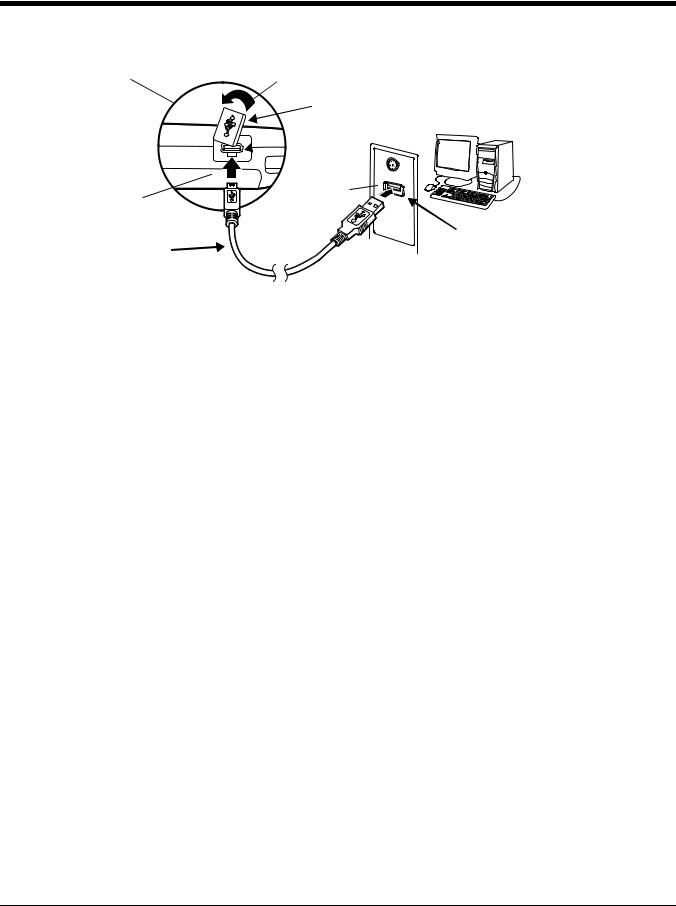
Option 2: Charging from a high power USB port on a host device (PC)
Left Side Panel of Dolphin 60s |
1 |
|
USB Door
Micro USB

 Port
Port
2 |
3 |
 USB Port on Host Device
USB Port on Host Device
USB Charging/ Communication Cable 
Note: Charging the battery through a USB port takes more time than direct AC adapter charging. USB charging will not take place if the terminal is drawing more current than supplied by the USB port.
Touch  > Settings > System > Power to verify the battery is charging.
> Settings > System > Power to verify the battery is charging.
To access detailed information on the battery, touch  > Settings > System > Battery.
> Settings > System > Battery.
Step 3. Boot the Terminal and Access the Home Screen
The terminal begins booting as soon as power is applied. Do not press any keys or interrupt the boot process. When the boot process is complete, the Home screen appears depending on your Dolphin model.
Note: During the initial charging stage, the terminal display may dim to conserve battery power due to inactivity. Touch the display to turn on the backlight.
2 - 3
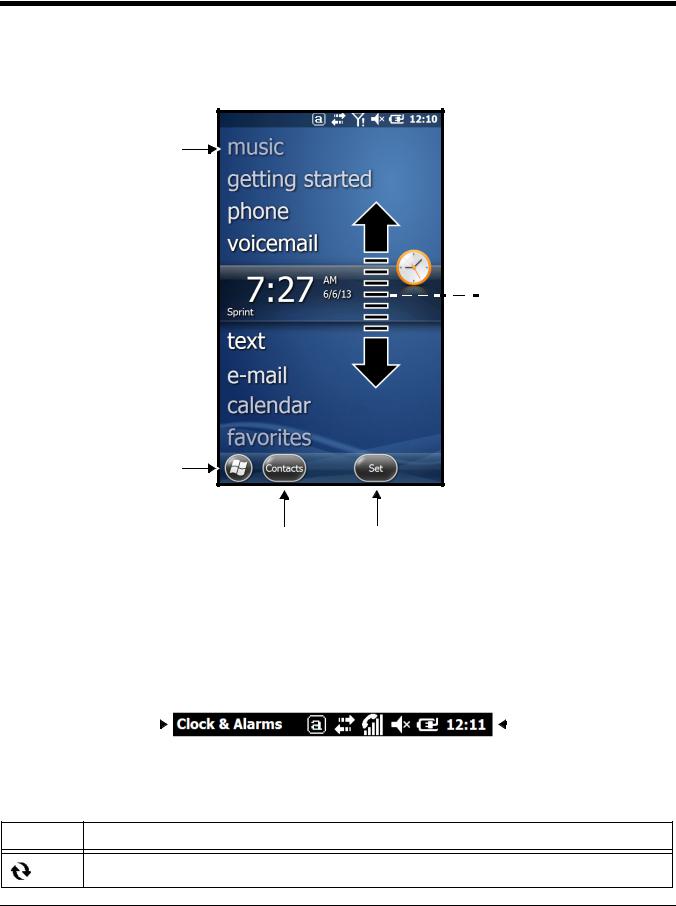
The Home Screen
After the Dolphin terminal initializes, the Home screen appears.
Touch a menu item to access additional screens.
Touch  to access the Start menu.
to access the Start menu.
 Title Bar (page 2-4)
Title Bar (page 2-4)
Swipe up or down with your finger or stylus to scroll through the menu items.
 Tile Bar (page 2-7)
Tile Bar (page 2-7)
Touch to access the |
Touch to access the Clock & |
Contacts screen. |
Alarms settings screen. |
Title Bar
The Title bar, located at the top of the screen, displays the active program, the status of various system functions, and the current time. Touching on the title bar provides access to the Horizontal Scroll. The scroll provides access to additional programs and application screens. For additional information, see Horizontal Scroll on page 2-7.
Text here indicates |
|
|
|
|
|
Icons here indicate the |
|
|
|
||||
the active program. |
|
|
|
status of various system |
||
|
||||||
|
|
|
|
|
|
functions. |
Icons in the Title Bar
Indicator Meaning
Synchronizing data
2 - 4
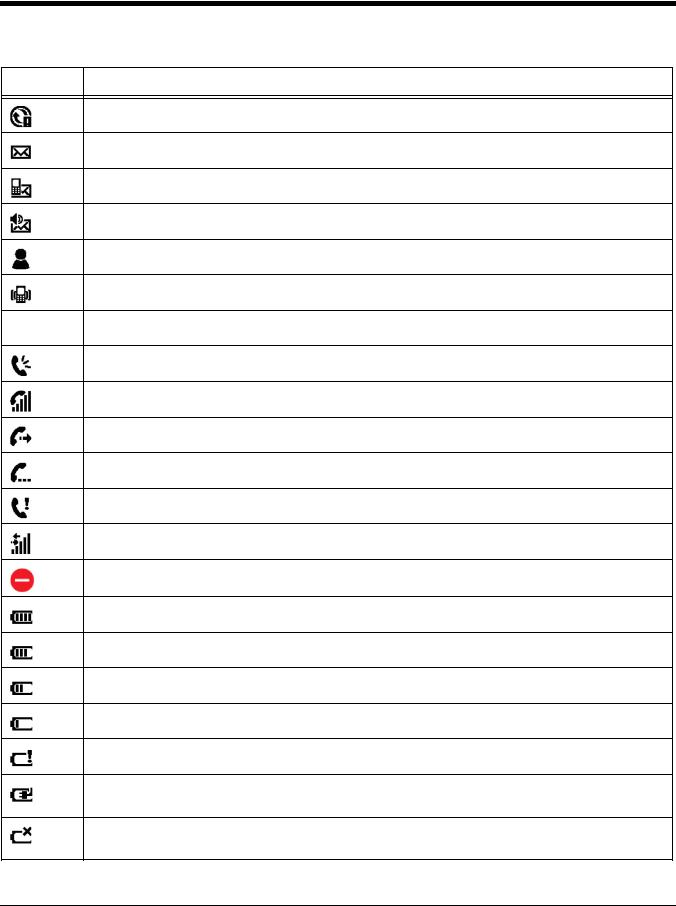
Icons in the Title Bar
Indicator Meaning
The terminal could not synchronize data with the workstation via ActiveSync.
New e-mail
New text message
New voicemail
New instant message
Vibrate on
Ringer off
Speaker phone on
Voice call in progress
Calls are forwarded
Call on hold
Missed call
Data call in progress
A battery error has occurred. Replace the main battery with a Honeywell Li-ion battery pack.
Battery is has a full charge
Battery has a high charge
Battery has a medium charge
Battery has a low charge
Battery has a very low charge and requires charging
Terminal is running on external power. If a battery pack is installed, the battery is charging in the background.
The terminal is not connected to external power. A battery is installed, but is defective; specifically, its charge level cannot be measured.
2 - 5
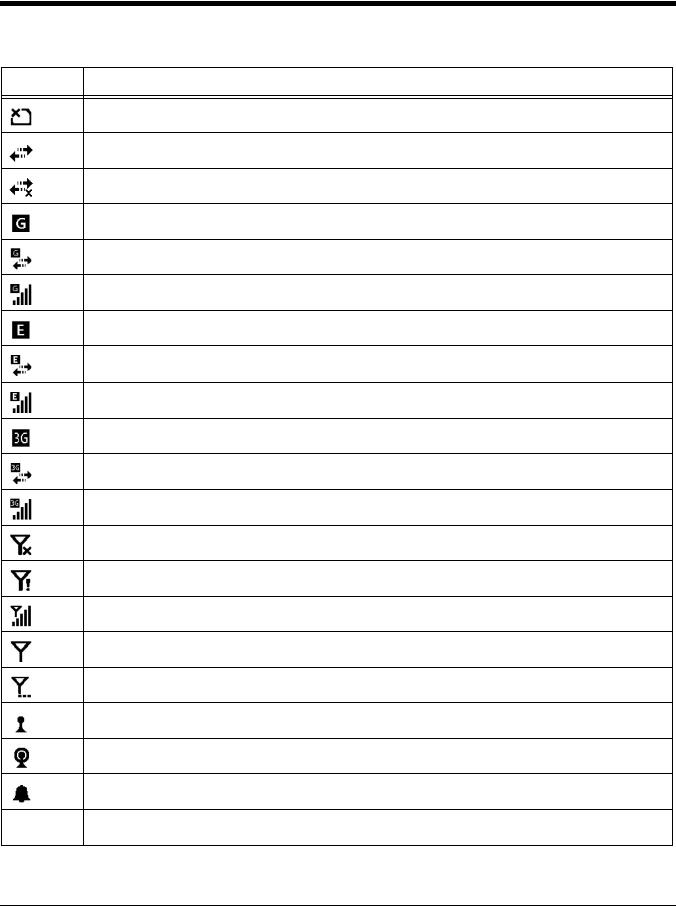
Icons in the Title Bar
Indicator Meaning
No SIM card is installed
Active network connection
No active network connection
GPRS available
GPRS connecting
GPRS in use
EDGE available
EDGE connecting
EDGE in use
UMTS available
UMTS connecting
UMTS in use
Radio is off
The radio is not connected to a network.
The radio is connected. The bars indicate the signal strength.
No radio signal
The terminal is searching for a signal.
Wi-Fi is on, but device is not connected
Wi-Fi data call
Pending alarm
Bluetooth
2 - 6

Horizontal Scroll
The Horizontal Scroll, located at the top of most application windows, provides access to additional application screens. You can swipe left or right on the scroll or touch each label on the scroll, until you get to the desired screen. Touching a label to the left or right of the center item brings new labels into view.
Note: Touch the Title bar to access the horizontal scroll if it is not visible on the screen.
The content of the Horizontal scroll changes according to the open application.
Tile Bar
The Tile Bar is located at the bottom of an application window.
Touch |
to access the |
|
|
|
|
|
|
|
|
|
|
|
|
The Tile Bar displays icons you |
|
|
|
|
|
|
|
||||||||
|
|
|
|
|
|
|
|
|
|
|
||||
|
|
|
|
|
|
|
||||||||
Start menu (page 2-9). |
|
|
|
|
|
|
|
|
|
use to open and close screens, |
||||
|
|
|
|
|
||||||||||
|
|
|
|
|
|
|
|
|
|
|
|
|
|
menus, and features. |
|
|
|
|
|
|
|
|
|
|
|
|
|
||
|
|
|
|
|
|
The icons change according to the open application. |
||||||||
Optional Virtual Keyboard
The virtual keyboard is licensed for a fee. If you attempt to upload a keyboard to your device and the following error message is displayed:
It indicates that you have not yet purchased a license for your device. Contact your Honeywell Sales representative for assistance. For contact information, see Technical Assistance on page 14-1.
The virtual keyboard appears when you open an application or select a field that requires text or numerical input. You can also touch the keyboard icon on the tile bar to toggle the keyboard on or off.
Touch the keyboard icon to toggle the Virtual Keyboard on or off.
When you touch and hold the keyboard icon, a pop-up menu allows you to switch between the default enhanced Honeywell virtual keyboard, which is fully customizable or the standard Windows Embedded Handheld virtual keyboard.
2 - 7

The Enhanced Honeywell Virtual Keyboard
During text input, you may need to switch between keyboard modes to access additional character sets (e.g., function keys, symbols, and numbers). Each keyboard mode, includes navigation keys, which allow you to quickly switch between modes. Touch the ABC key to switch to the Qwerty Mode, the 123 key to switch to the Numeric Mode, and the #@& key to switch to the Function & Symbols Mode.
Note: The content of the keyboard and the mode initially displayed may vary depending on the application in use and the input field requirements.
Alternate Keys
Some keys include a second symbol in red. In order to use the alternate symbol, press and hold the key until the alternate symbol appears, then release the key to type the symbol.
Honeywell Virtual Keypad Creator
The default enhanced virtual keyboard is fully customizable using the Honeywell Virtual Keypad Creator software available for download at www.honeywellaidc.com. The user-friendly utility allows you to personalize multiple keyboard features including key position, size, quantity, color, and the keyboard skin. In addition, you can make language changes, create alternate or function keys for special character sets, and add application launch keys to streamline common business tasks.
Virtual Keypad consists of two software applications. The first is the Virtual Keypad Creator, which resides on your PC and is used to design and save keypad layouts. The second is the Virtual Keypad, which is downloaded to your mobile device. The Virtual Keypad on your mobile device displays the keypad you designed using Virtual Keypad Creator.
The customization process is easy. Simply download and install the Virtual Keypad Creator software onto your PC, modify the provided standard template, then download the customized keyboard to your terminal using a USB connection.
2 - 8
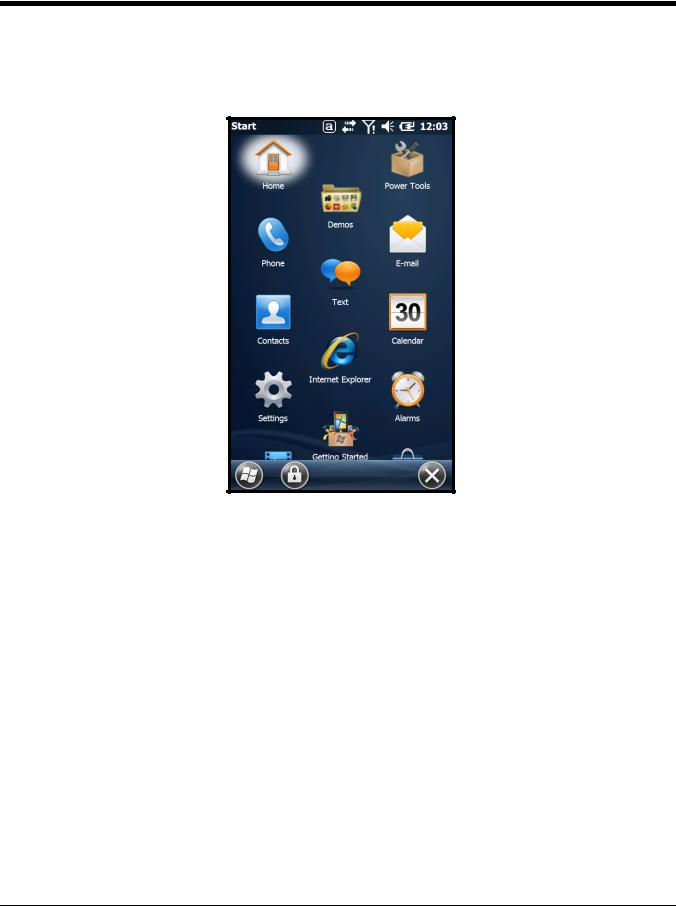
The Start Menu
To see the programs loaded on your terminal, touch  to access the Start menu.
to access the Start menu.
Navigating the Start Menu
•Swipe up or down with your finger or stylus to scroll through the menu icons.
•To open a program, touch once on the program icon.
•To reposition an icon on the Start menu, touch and hold the stylus on the icon, then drag the icon to the desired position.
Pop-Up Menus
With pop-up menus, you can quickly choose an action for a selected item. To access a pop-up menu, touch and hold the stylus on the item name of the action you want to perform. When the menu appears, lift the stylus, and touch the action you want to perform.
Touch anywhere outside the menu to close the menu without performing an action.
2 - 9
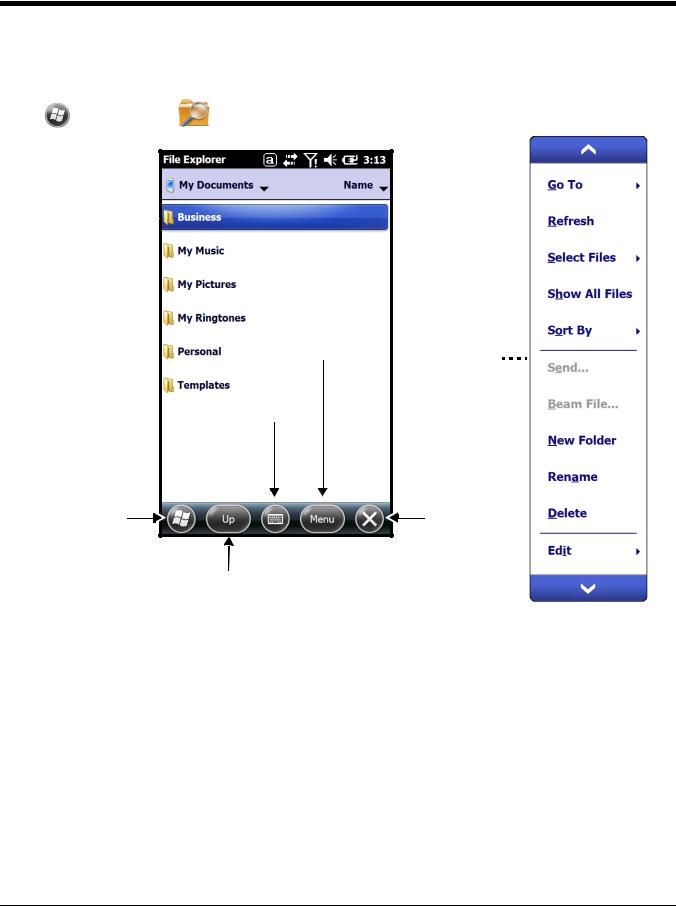
File Explorer
You can use the File Explorer to find files and organize files into folders.
Touch |
> File Explorer |
. |
Touch on the name to 
 open a file or folder.
open a file or folder.
Touch to toggle the  keyboard display on or off.
keyboard display on or off.
Touch and hold to access a pop-up menu of keyboard options.
Touch to return to the Start menu.
 Touch to access additional Menu options.
Touch to access additional Menu options.
Touch to close
File Explorer.
Touch to move Up one level in the directory.
To move or copy files between folders using File Explorer:
1.Touch and hold on the item you want to move, then touch Cut or Copy on the popup menu.
2.Navigate to the folder you want to move or copy the file to, then touch and hold a blank area of the window.
3.Touch Paste on the pop-up menu.
Note: If there is no blank space available in the window, touch Menu on the tile bar, navigate to the end of the menu using the down arrow, then touch Edit > Paste.
2 - 10

File Provisioning on the Dolphin 60s
\IPSM\Honeywell
The IPSM folder is the only partition on the terminal that persists across a kernel upgrade (*.UPG file extension). During a kernel upgrade, files are automatically copied from the \IPSM\Honeywell folder and then installed in the \Honeywell (root file system) folder as part of the upgrade process.
\IPSM\Honeywell\AutoInstall
The files in the IPSM\Honeywell\AutoInstall folder are only installed when a factory reset or kernel upgrade occurs. Once the files are installed, they persist through hard and soft resets. If a file is added to the folder and a hard or soft reset is performed, it will have no effect. If a program is manually removed using the Remove Programs application (see page 7-20), then the program is not automatically re-installed on a hard or soft reset.
\Honeywell
The Honeywell partition or root file system partition is persistent over a hard reset, soft reset, and the removal of the battery pack or the removal of AC power. However, during a kernel upgrade the root file system is reformatted so all data in the folder is deleted and replaced by any files in the \IPSM\Honeywell folder as part of the upgrade process.
!To prevent data loss, back up all user data to an SD card or external memory device before performing an upgrade.
\Honeywell\AutoInstall
If you run a CAB file from within the \Honeywell\AutoInstall (user store) folder, after the program has been installed, the CAB file will be deleted from the User Store. However, the program remains installed through all successive Hard and Soft resets.
If you want the program to be part of the Autoinstall that occurs after a factory reset or software upgrade, paste the program file(s) in both the \IPSM\Honeywell\Autoinstall folder and the
\Honeywell\Autoinstall.
Contact a Honeywell technical support representative for information on how to perform a factory reset or for information on available software upgrades for your Dolphin terminal. For contact information, see Technical Assistance on page 14-1.
!To prevent data loss, back up all user data to an SD card or external memory device before performing an upgrade.
Search
The Search feature helps you quickly locate information. Touch  > Search Phone
> Search Phone  .
.
Enter the text you want to find, select a data type, and then touch Search. Select Larger than 64 KB in the Type drop-down field to quickly find information that is taking up storage space.
2 - 11
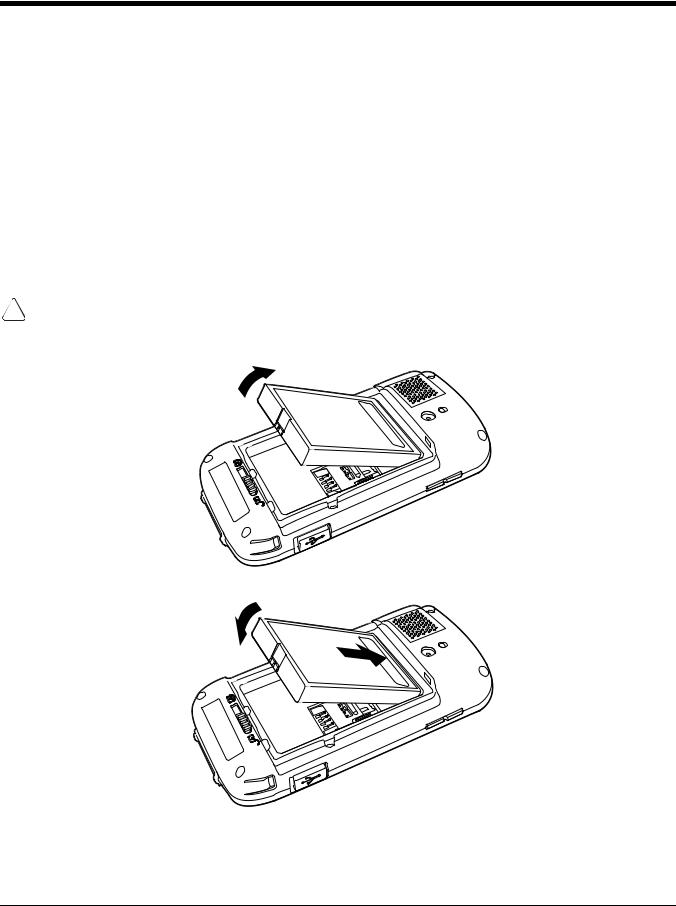
Suspend Mode
In Suspend mode, the device enters a low power state to conserve battery power. The radio associated with the phone maintains enough power to wake the terminal for incoming phone calls.
Suspend mode automatically turns the touch screen off to save battery power when the terminal is inactive for a programmed period of time. The automatic timeout limits are adjustable from the
Advanced tab located under Settings > System > Power (see page 7-18).
To put the device into Suspend mode, press and release the Power key  for approximately 4-5 seconds. To resume from the Suspend mode, press and release the Power key.
for approximately 4-5 seconds. To resume from the Suspend mode, press and release the Power key.
Replacing the Main Battery
Note: Before replacing the main battery, read the Guidelines for Battery Pack Use and Disposal on page 3-13.
!Ensure all components are dry prior to mating terminals/batteries with peripheral devices. Mating wet components may cause damage not covered by the warranty.
1.Remove the battery door, slide the latch to unlock the battery door, remove the battery door, then remove the battery.
2.Insert the new battery, then attach and lock the battery door.
Note: Do not attempt to use the terminal without the battery door installed.
3.The terminal begins booting as soon as power is applied.
2 - 12

!We recommend use of Honeywell Li-ion battery packs. Use of any non-Honeywell battery may result in damage not covered by the warranty.
Resetting the Terminal
There are three types of system resets: a Soft Reset, a Hard Reset, or a Factory Reset. The soft and hard resets preserve all data stored in the file system. Contact a Honeywell technical support representative for more information on how to perform a Factory Reset. For contact information, see Technical Assistance on page 14-1.
Soft Reset (Warm Boot)
A Soft Reset re-boots the device and preserves any objects created in RAM. You would perform a soft reset when: the terminal fails to respond, after installing some software applications, or after making changes to certain system settings, such as network cards.
To perform a Soft Reset:
1.Press and hold the Blue key  and then Power key
and then Power key  for approximately 6-7 seconds.
for approximately 6-7 seconds.
2.When the reset is complete, the Home screen displays.
Hard Reset (Cold Boot)
A Hard Reset re-boots the terminal and closes any open applications running in RAM at the time of the reset.
To perform a Hard Reset:
1.Press and hold the Blue key  and then Send key
and then Send key  for approximately 6-7 seconds.
for approximately 6-7 seconds.
2.When the reset is complete, the Home screen displays.
2 - 13

2 - 14
